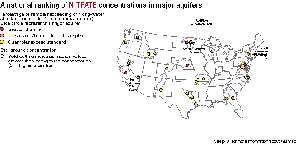U.S. Geological Circular 1225--The Quality of Our Nation's Waters--Nutrients and Pesticides
From a national perspective, nitrate contamination did not pose a health risk for residents who drank water from major aquifers buried relatively deep below land surface. Some concerns were evident, however, in 4 of the 33 major aquifers sampled. In each of these four aquifers, nitrate concentra-tions in more than 15 percent of samples exceeded the USEPA drinking-water standard. All four aquifers are relatively shallow, in agricultural areas, and composed of sand and gravel that is vulnerable to contamination by land application of fertilizers. In nearly one-half of the major aquifers sampled, water from at least one well, out of 20 to 30 wells, exceeded the drinking-water standard. Many of the major aquifers exhibiting high nitrate concentrations were used for rural domestic water supply.
 |
| image size 9KB--gif |
About 15 percent of all shallow ground water sampled beneath agricultural and urban areas exceeded the drinking-water standard for nitrate. The presence of elevated nitrate concentrations in shallow ground water raises concerns, particularly where these vulnerable aquifers contain deeper wells used for rural domestic water supply. Contamination of shallow ground water may be a warning to alert populations to potential future risks from consumption of water from deeper wells in these aquifers.
Because of its proximity to the land surface, shallow ground water is younger and more vulnerable to contamination from human activities than deep ground water. Major aquifers generally are buried deep beneath the land surface, where they are protected by layers of clay or rock that are relatively impermeable and that impede downward movement of water and nitrate. Ground water in major aquifers sampled by the NAWQA Program can be tens to hundreds of years old and, therefore, minimally affected by recent land-use practices.
Geology and hydrology control the movement of contaminated water from shallow to deep systems, and understanding their effects allows an anticipation of possible areas of concern in major aquifers. For example, elevated concentrations of nitrate were detected in a major aquifer in the Lower Susquehanna River Basin (median concentration about 7 mg/L) because karst (weathered carbonate rock) contains open conduits that allow rapid downward movement of water and chemicals. Median concentrations of nitrate also were high in the alluvial aquifer of the Central Nebraska Basins (about 6 mg/L) and in the alluvial fans of the San Joaquin-Tulare Basins (about 5 mg/L). Extensive pumping causes vertical mixing of ground water in these relatively permeable sand and gravel aquifers. In contrast, the median concentration of nitrate was low (0.4 mg/L) in a surficial sand and gravel aquifer in the Red River of the North Basin; however, 15 percent of the samples exceeded the drinking-water standard. This last example demonstrates the complex effects that local geology and nitrate sources can have on nitrate contamination.
|
From a national perspective, nitrate did not pose a health risk for residents who drank water from major aquifers buried relatively deep below the land surface. People drinking ground water from shallow wells in vulnerable geologic settings (sand, gravel, or karst) in rural agricultural areas, however, are at risk of exposure to nitrate contamination. |
For large rivers and most of the smaller streams sampled, nitrate is not a drinking-water issue. This conclusion is based on comparisons of average annual and average monthly concentrations to the drinking-water standard. In only two of all sampled rivers and streams did the average annual concentration of nitrate exceed the drinking-water standard. These two streams drained small agricultural watersheds in the Lower Susquehanna River and Willamette Basins, and neither was used to supply drinking water.
| Nutrients are a potential concern for aquatic life | |
| Human activities have increased nutrients above background concentrations | |
| The Quality of Our Nation's Water--Nutrients and Pesticides |